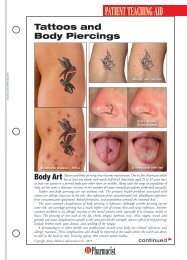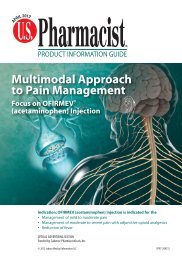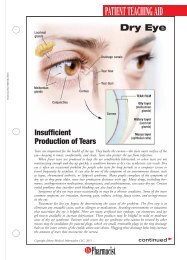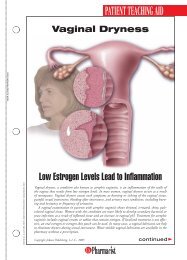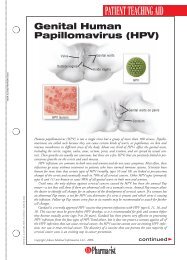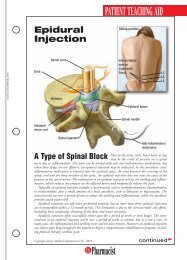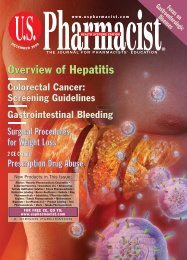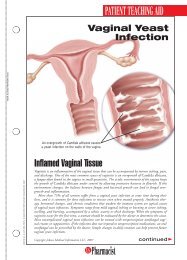View PDF Edition - U.S. Pharmacist
View PDF Edition - U.S. Pharmacist
View PDF Edition - U.S. Pharmacist
Create successful ePaper yourself
Turn your PDF publications into a flip-book with our unique Google optimized e-Paper software.
So Many Options,So Little Differencein EfficacyWhat Is the AppropriateAntidepressant?Uncertainty is high when it comes to selectingthe appropriate antidepressant for patients diagnosedwith major depressive disorder (MDD),not only because studies have reported no differences inefficacy between agents, but also because only 11% to30% of patients will reach remission with initial treatment,even after a year. 1,2 This consequently has led cliniciansto practice in a trial-and-error fashion to treatdepression. 3 Furthermore, the last major revision of theDiagnostic and Statistical Manual of Mental Disorders(DSM-IV-TR) was produced in 2000. 4 In 2005, a guidelinewatch was published to review important safety concernsthat had emerged about some agents, such asnefazodone, as well as to review two new antidepressantsapproved that year, escitalopram and duloxetine. 5 Revisionand update of the DSM-IV-TR (DSM-V manuscript)is not due until May 2012. Therefore, there is need foran up-to-date review to assist clinicians in deciding onthe appropriate agents to treat individual patients.The 2007 Sequenced Treatment Alternatives to RelieveDepression (STAR*D) study attempted to develop andevaluate feasible treatment strategies to improve clinicaloutcomes for patients with treatment-resistant depressionwho were identified with a current major depressiveepisode. 6 Specifically, STAR*D aimed to determine whichof several treatments is the most effective “next step” forpatients who do not reach remission with an initial orsubsequent treatment or who cannot tolerate the treatment.The overall results of this study demonstrated thatpharmacologic differences between psychotropic medicationsdid not translate into substantial clinical differences,although tolerability differed. 6The purpose of this article is to review treatment evidenceavailable in the literature inorder to provide a quick reference thatwill help clinicians decide on theappropriate agent, taking into considerationadverse effects, drug interactions,and medication safety, as wellas patient characteristics.Marjorie Rochette DeLucia, PharmD, MSPGY1 Pharmacy Practice ResidentBaptist Medical CenterJacksonville, FloridaMichael J. Schuh, PharmD, MBAAmbulatory <strong>Pharmacist</strong>, Mayo ClinicJacksonville, Florida© JUPITERIMAGESWhat Is Depression?Depression can be a chronic or recurrent mental disorderthat presents with several symptoms such asdepressed mood, loss of interest or pleasure, feelingsof guilt, disturbed sleep or appetite, low energy, anddifficulty thinking. 7 Depression can lead to substantialimpairment in an individual’s ability to take careof everyday responsibilities. Depression can also lead tosuicide, a tragedy accounting for the loss of about850,000 lives worldwide every year. 7Prevalence and At-Risk PopulationsThere are an estimated 121 million people worldwideaffected with depression. 7 In 2000, depression was thefourth leading contributor to the global burden of diseaseamong all diseases, and by 2020 it is anticipatedthat it will rise to the number-two leading contributorto the global burden of disease, second only to heartdisease. 7Populations at higher risk for developing depressioninclude women, people between the ages of 24 and 45years, and those with first-degree relatives with depression.Women are at increased risk for depression untiltheir 50s, and their lifetime risk is two times greater thanmen’s. People between the ages of 24 and 45 yearsexperience the highest rate of depression. Finally, firstdegreerelatives of depressed patients are 1.5 to 3 timesmore likely to experience depression than others. 4,8Pathophysiology andPharmacotherapy RationaleBiological and psychosocial causes have been hypothesizedin an attempt to describe the pathophysiology ofdepression. Pharmacologic agents willtarget the biological causes linked todysregulation in the neurotransmitters.This dysregulation is oftendescribed as a deficiency in brain neurotransmitterlevels. Norepinephrine,serotonin, and dopamine levels26U.S. <strong>Pharmacist</strong> • November 2009 • www.uspharmacist.com




